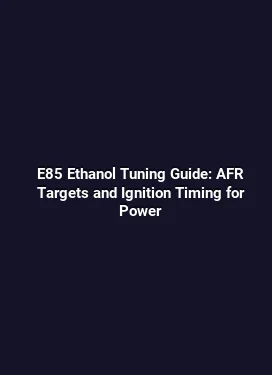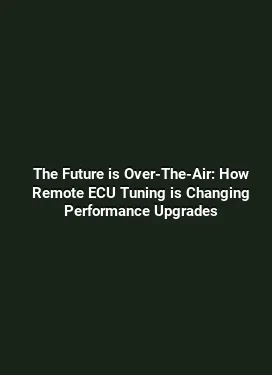Cobb AccessPort Stage 1 vs Stage 2 Tune Comparison for Subaru WRX
For Subaru WRX owners seeking to optimize engine performance, the Cobb AccessPort (AP) represents a modular and tuner-friendly approach to engine management. This comparison focuses on two popular stages within the Cobb ecosystem: Stage 1 and Stage 2 tunes. The aim is to provide actionable, data-informed guidance about how each stage alters airflow, fueling, timing, and overall drivability, while highlighting practical considerations such as compatibility, supporting modifications, and long-term reliability. By examining real-world implications, enthusiasts can make informed decisions about which stage aligns with their goals, whether that means street-driven daily performance, spirited weekend runs, or track-ready setups.
Key terms and concepts surface repeatedly when discussing engine management and tuning. While avoiding heavy technical jargon, it’s essential to understand how fuel delivery, ignition timing, turbocharger response, and intercooler efficiency interact. The Cobb AP enables custom calibration, allowing access to the ECU maps that control these factors. The Stage 1 tune typically targets improved power with minimal hardware changes, whereas Stage 2 introduces additional modifications and more aggressive fueling strategies to extract higher performance from the same turbocharged boxer engine. The results can vary based on the specific WRX model year, turbo configuration, and supporting components such as intake, exhaust, and intercooler sizing.
Understanding Cobb AccessPort Stages for Subaru WRX

The AccessPort is designed to load pre-tuned maps that optimize the engine’s air-fuel ratio, ignition timing, and boost targets within safe limits for the stock turbo, fueling system, and internals. Stage 1 focuses on a refined calibration that takes advantage of the factory hardware while maximizing efficiency and response. Stage 2, on the other hand, assumes the presence of additional hardware or substantial changes—such as a larger turbo or upgraded intake and exhaust components—and follows a more aggressive calibration approach to unlock higher boost, improved torque, and a broader power band.
From a practical standpoint, Stage 1 typically yields noticeable gains in midrange torque and throttle response without requiring significant modifications. It emphasizes drivability, smooth power delivery, and compatibility with daily driving. Stage 2 aims to push the limits of the stock engine’s cooling capacity and fuel delivery system, delivering higher peak horsepower and broader RPM coverage. The trade-offs often involve increased heat generation, potential shifts in fueling behavior at the upper end of the RPM range, and the need for supporting upgrades to maintain reliability under higher loads.
Stage 1 vs Stage 2: Core differences

Several core pillars differentiate the two stages. First, boost targets typically rise from Stage 1 to Stage 2, necessitating calibrated adjustments to wastegate behavior and turbo response. Second, fueling strategies evolve: Stage 1 maintains a safe margin for part-throttle efficiency, while Stage 2 introduces more aggressive enrichment at higher loads. Third, timing changes accompany the boosted environment—refinements to ignition advance help maximize power without compromising detonation margins. Fourth, the cooling demand increases with Stage 2, making intercooler efficiency and charge air temperature management more critical.
Stage 1 is often categorized as a refined improvement over stock without hardware changes, delivering a broad usable torque curve. Stage 2 represents a higher-performance tier that assumes, or benefits from, logical supporting modifications to sustain higher power and consistent performance across more demanding driving scenarios. The result is a noticeable uplift in straight-line acceleration, alongside a more linear throttle response that remains composed under spirited driving.
Performance Gains: Realistic Expectations and Measurements
Performance gains from Stage 1 are generally in the range of 15% to 25% at the wheels on a stock WRX, depending on atmospheric conditions and the specific model year. The improvements are most evident in mid-range torque and throttle response, where a quick surge of power makes daily driving feel more engaging without compromising smoothness. A common observation is a more linear pull as boost comes on earlier in the rev range, reducing the sensation of turbo lag and providing tangible acceleration in urban and highway scenarios alike.
Stage 2 gains can push the wheel horsepower into the 25% to 40% range in favorable conditions, though this is highly contingent on supporting hardware, fuel quality, and proper tuning. The upper end of the rev range often shows the most dramatic gains, with a wider peak power band and improved sustained power during extended pulls. However, these gains come with increased thermal load and a need for confidence in cooling performance and fuel delivery accuracy. Data logging, dyno testing, and real-world drive tests are invaluable for validating Stage 2 configurations before regular use on the street or track.
Practical examples of dyno and road behavior
In a controlled dyno session, Stage 1 can shift the horsepower curve upward by a consistent margin across mid-to-high RPMs, while maintaining manageable IAT (intake air temperature) and AFR (air-fuel ratio) targets. On the road, this translates to smoother overtakes and more decisive acceleration without sudden surges. Stage 2, conversely, often demonstrates a sharper peak and a broader spread of torque, enabling quicker shifts and more aggressive passes, provided cooling and fueling keep up with the demands. Real-world feedback emphasizes the importance of data-driven tuning to avoid heat soak and detonation risks when maximizing power output.
Fueling, Timing, and Tire-Side Implications
Fueling strategy is central to the difference between Stage 1 and Stage 2. Stage 1 calibrations commonly optimize the factory injectors and pumps to deliver a safe, efficient mixture that preserves fuel economy and reliability. The AFR targets stay close to the OEM baseline but lean slightly toward higher performance without crossing thresholds that could threaten engine safety. Stage 2 tunes push the boundaries further, requiring more precise control over fueling during high-load events. This often means richer mixtures during boost transitions and calibrated fueling ramps to maintain consistent cylinder pressures and prevent knock under heavy boost.
Ignition timing also advances with Stage 2, allowing the engine to extract more usable energy from the boosted air charge. The challenge is maintaining a safe margin against detonation, especially under hot weather, high humidity, or aggressive driving styles. The result is a carefully tuned balance where timing advances align with boost onset and cooling capacity. The outcome is not just peak power; it is consistent power delivery across shifts and RPM bands, yielding more predictable performance in track or twisty road scenarios.
Cooling and thermals: essentials for Stage 2 reliability
Stage 2's higher boost and enriched fueling generate more heat in the intake tract, exhaust system, and within the engine. Efficient intercooling and robust charge-air cooling become crucial. Upgrades such as a larger intercooler core, improved intake piping, and careful heat management under the hood can help maintain charge temperatures within safe limits. This is particularly important for daily drivers who may encounter warm climates or prolonged high-load events. In practice, monitoring tools that track intake air temps, boost pressure stability, and torque delivery can inform when cooling improvements are warranted to sustain Stage 2 performance over time.
Hardware, Compatibility, and Required Upgrades
Stage 1 is generally compatible with stock hardware, enabling a straightforward upgrade path for many WRX owners. It is essential to ensure the vehicle is in good mechanical health—tightened fuel system, clean air intake, and intact intercooler seals help maximize the potential gains without introducing risk. Stage 2, however, often benefits from or requires supportive hardware to sustain higher boost and power levels. Common considerations include a higher-capacity fuel pump, upgraded fuel injectors, a stronger intercooler setup, and, in some cases, a larger turbocharger or optimized exhaust components. The goal is to provide reliable airflow and fuel delivery that match the increased boost and torque, reducing the likelihood of lean conditions or heat-related detuning.
From a tuning perspective, Stage 2 setups may leverage more aggressive spark maps and refined boost control strategies. The complexity of calibrations increases, emphasizing the importance of meticulous data logging, high-quality fuel, and a controlled environment for development. A well-planned Stage 2 build accounts for tire choice, suspension dynamics, and braking capacity since higher output magnifies the demands on chassis systems and traction control. In practice, many WRX enthusiasts pair Stage 2 with a comprehensive upgrade plan that includes intake, exhaust, intercooler, fueling upgrades, and a properly chosen camshaft or turbo options where appropriate.
Choosing the right combination for your goals
For daily drivers prioritizing a balanced blend of power, reliability, and ease of use, Stage 1 provides a substantial uplift without introducing heavy maintenance requirements. For enthusiasts seeking track-focused performance or weekend warriors chasing maximum output, a Stage 2 route with a compatible hardware stack can deliver superior top-end power and a more commanding throttle response—provided cooling and fueling systems are upgraded accordingly. The decision should align with driving habits, climate, fuel quality, and willingness to manage more complex maintenance and tuning routines.
Reliability, Safety, and Long-Term Considerations
Engine management tuning introduces new operating envelopes. While Stage 1 is typically conservative enough to preserve long-term reliability, Stage 2 requires careful attention to heat management, fuel compatibility, and detonation risk. Regular maintenance, including air filter upkeep, intercooler integrity checks, vacuum lines, and sensor health, supports stable operation. Monitoring tools that track data such as knock events, IATs, AFR, and boost stability help preempt issues before they impact performance or reliability. A proactive approach to tuning—documenting changes, testing under varied loads, and validating performance with controlled tests—provides a durable path to sustained results.
Another critical factor is fuel quality. Higher-performance tunes demand consistent octane levels to maintain detonation margins. In regions with variable fuel quality, riders may choose to adapt their maps or employ octane booster strategies where appropriate, balancing performance aspirations with safety margins. The overarching principle remains: performance gains should not come at the expense of reliability or engine health. A thoughtful, staged approach—starting with Stage 1 and evaluating results before proceeding to Stage 2—offers a safer, more controllable upgrade path.
Finally, the tuning community emphasizes the value of data-driven adjustments. Keeping logs of drive cycles, track sessions, and dyno results helps builders refine maps and ensure Stage 1 or Stage 2 remains responsive and safe across environmental conditions. The result is a more satisfying ownership experience, with measurable performance improvements that align with individual driving styles and goals.





